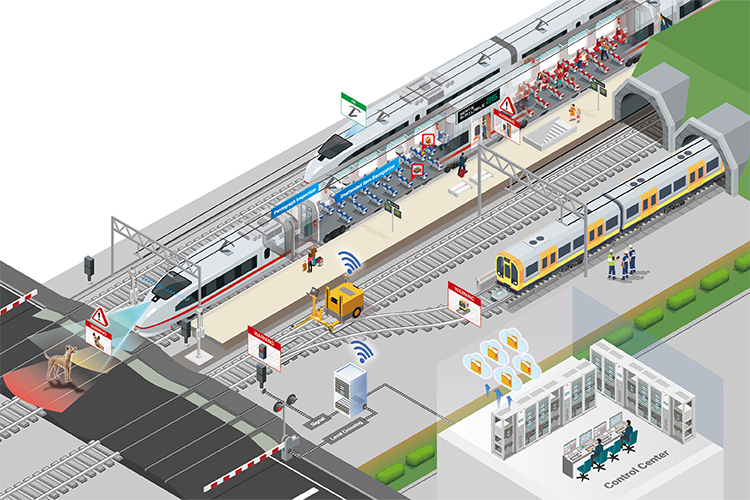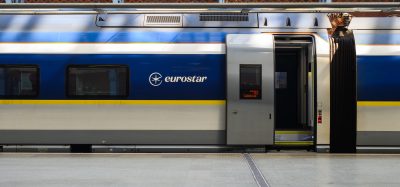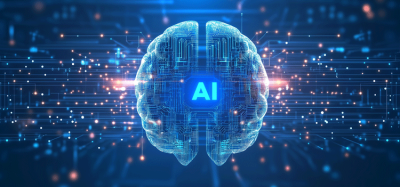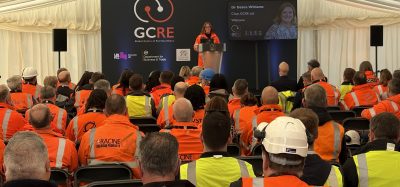Forging the Future of Mobility: The Role of Edge AI Computer in Intelligent Transportation
Posted: 21 October 2024 | Neousys Technology | No comments yet
How to digitise railway operations today with rugged edge AI computers.


Overview
Intelligent Transport Systems (ITS) are essential components of smart cities, enhancing the efficiency, safety, and sustainability of urban transportation networks. These systems leverage advanced technologies, such as IoT, big data analytics, and AI, to optimize traffic management, reduce congestion, and improve public transportation. By integrating various modes of transport, ITS facilitates seamless mobility for residents, offering real-time information on traffic conditions, public transport schedules, and alternative routes.
In the context of intelligent railways, ITS plays a pivotal role in transforming urban rail systems into more responsive and user-friendly networks. Intelligent railways utilize real-time data to monitor train operations, enhance safety protocols, and improve passenger experiences. Features such as automated train control, track intrusion detection, carriage monitoring, predictive maintenance, and smart ticketing systems streamline operations, minimize delays, and ensure safety. Additionally, real-time passenger information systems provide updates on train schedules and capacity, enabling transiting travelers to make informed decisions on the fly.
Moreover, intelligent railways contribute to sustainability by promoting energy-efficient operations and reducing carbon footprints. By integrating with other transport modes, such as buses and bicycles, intelligent railways facilitate a holistic approach to urban mobility, ensuring that smart city residents can navigate their environment effortlessly. Overall, the integration of ITS in smart cities, particularly within intelligent railways, enhances urban living and supports future growth.
What does the digital transformation of rail mean?
Digitizing or “intelligenizing” railway operations refers to the integration of advanced technologies and data-driven systems to enhance efficiency, safety, and passenger experience in rail networks. This process involves implementing IoT devices, AI, and big data analytics to monitor and manage various aspects of railway operations in real time.
Key components include automated train control systems that optimize schedules and track intrusion systems to improve safety by preventing collisions, and predictive maintenance technologies that analyze data to foresee equipment failures before they occur. Smart ticketing solutions streamline fare collection, allowing passengers to use mobile apps for easy access to services.
Moreover, real-time information systems keep passengers informed about train schedules, delays, and platform changes, enhancing overall travel experience. By connecting railway systems with other modes of transport, digitization promotes seamless interconnecting travel with buses, inner city light rails, flights, etc.
Ultimately, intelligenized railway operations not only increase operational efficiency and reliability but also support sustainability goals by reducing energy consumption and emissions, making rail travel a more attractive option for urban mobility.
What are the main challenges rail operators face when deploying heterogeneous (hybrid) computing?
Rail operators face several hardware deployment challenges when integrating edge AI computing into digitized railway operations.
First, infrastructure upgrades are often necessary, as existing legacy systems may lack the capacity to support advanced technologies. This requires significant investment and planning, leading to potential disruptions during implementation.
Second, data integration poses a challenge; consolidating data from various sources—such as sensors, trains, and maintenance systems—requires compatible architectures and standards. Ensuring data quality and consistency is crucial for effective AI analysis. Additionally, the new generation of sensors, such as high-resolution cameras, lidar, and radar, generate more and more data that requires a high-performance edge platform to process.
Third, the deployment of edge computing devices in diverse environments can be complex, requiring robust solutions that can withstand varying conditions, such as wide-varying ambient temperatures, electrical fluctuations, harsh environment conditions, etc.
What key solutions can Neousys offer the industry that will bring benefits?
Ruggedness, Reliability and Stability
Neousys Technology’s industrial edge AI computers play a pivotal role in advancing railway digitization through their rugged and reliable design. Engineered with a robust rugged DNA, these systems are capable of enduring the harsh conditions typically encountered in railway environments. Their true wide temperature operation guarantees consistent performance in extreme climates, crucial for maintaining operational integrity.
EN50155 and EN45545-2 Certified
With EN50155 and EN45545-2 certifications, Neousys computers meet stringent railway safety and fire protection standards, ensuring that they are safe for use in passenger and cargo transport. The MIL-STD certification further underscores their durability, enabling them to withstand shock and vibration—common challenges in rail operations. Additionally, the ignition control feature enhances safety by preventing unintended power activation.
NVIDIA Jetson (ARM) and Intel/ AMD (x86) Platforms
Flexibility is another key advantage, as Neousys offers edge AI systems based on both NVIDIA Jetson (ARM) and Intel/ AMD (x86) platforms. This versatility allows integrators to choose the best architecture for their specific applications, whether it’s for real-time data processing, predictive maintenance, or passenger experience enhancement.
Overall, Neousys Technology’s edge AI computers empower railway operators to leverage advanced technologies, drive efficiency, and enhance safety, paving the way for a more connected and intelligent rail infrastructure. Their combination of ruggedness, safety certifications, and implementation flexibility makes them an invaluable asset in the journey toward railway digitization.
Where Neousys solutions are being deployed
Neousys Technology rugged edge AI computers enable various applications that support real-time data processing and analytics on trains or track inspection vehicles to enhance safety, efficiency, and passenger experience.
On-board
- Advanced Driver Assistance Systems (ADAS): ADAS integrates real-time data processing and AI analytics. Utilizing Neousys platforms with ADAS can optimize railway safety, enable predictive maintenance, and improve operational efficiency, leading to smarter, more reliable rail systems.
- Driver Fatigue Alert Systems: Utilizing AI algorithms, Neousys edge AI platforms can monitor driver behavior, providing timely reminders for safety checks or alerts for fatigue, significantly reducing human error.
- Monitoring System: Neousys NRU NVIDIA Jetson systems are easy to deploy and implement; they can track passengers, number of, their movements and conditions, offering real-time data on occupancy and crowd management to ensure a comfortable travel experience.
Wayside
- Track Object Intrusion Detection: Neousys IP-rated SEMIL computers process data from sensors to detect unauthorized objects on tracks, providing instant alerts to prevent accidents and improve safety.
- Automated Pantograph Inspection: Automated GPU-aided AI systems can inspect pantographs in real time, ensuring the optimal contact with overhead lines, which enhances energy efficiency and reduces maintenance costs.
- Control, Command & Signaling (CCS): Neousys edge AI platforms enhance train crossing systems by utilizing real-time video analytics and sensor data. The systems help regulate all train traffic coming through and redirect tracks accordingly to ensure smooth traffic management, reducing the risk of accidents.
Train Station/ Control Room
- Facial and Limb Detection System: Neousys edge AI systems utilize advanced facial and limb detection to assess human behavior, identifying signs of stress, falls, or potential security threats. By analyzing physical cues in real-time, these systems enhance safety and response measures in various environments in public spaces.
- Video Recorders: High-definition video surveillance systems enhance security by continuously monitoring passenger areas and train operations. This aids in incident investigation and enhances overall safety.
What sets Neousys apart from your competitors, and how will you keep up with the changing demands of the future rail sector?
The ruggedness of Neousys systems ensures exceptional durability in harsh railway environments. Their true wide temperature operation supports reliable performance across diverse climates, allowing consistent functionality in extreme conditions where many competitor systems may struggle.
Unlike competitors that may use existing available solutions on the market, Neousys system’s thermal solution are designed from the ground up. By simplifying the heat conduction path for efficient heat dissipation; strategically segregate and position heat-generating components for even heat distribution to avoid heat-soak; combine them with Neousys’ unique mechanical design to further aid the system’s overall thermal dissipation efficacy to ensure true wide temperature operation from as low as -40°C, and up to 70°C, 24/7, while ensuring electronic component longevity in the process.
Another unique asset of Neousys systems is its SuperCAP power backup modules. Not only can it act as a power backup source in the event of unforeseen power failure, moreover, it is an effective medium safeguarding the system from railway’s fluctuating electricity, doubling down on operational security.
Neousys computers feature EN50155 and EN45545-2 certifications for railway safety and fire protection, ensuring the safety of passengers and cargo. With MIL-STD certification for shock and vibration resistance, they are robust. Neousys also offers edge AI systems on NVIDIA and Intel platforms, enabling flexible integration of advanced AI applications like predictive maintenance and real-time analytics, driving innovation in the railway sector.
Neousys Technology’s evolving DNA ensures that its systems remain future-proof. By prioritizing adaptability and resilience, these computers are equipped to support emerging technologies and applications in the railway sector, ensuring that operators can keep pace with advancements in digitization and smart infrastructure. This forward-thinking approach positions Neousys as a leader in the railway digitization landscape, committed to meeting the evolving demands of the industry.
Click Here for Neousys Product Information
Click Here for Neousys Railway Application Cases
Click Here for Neousys Edge AI Think Tank







